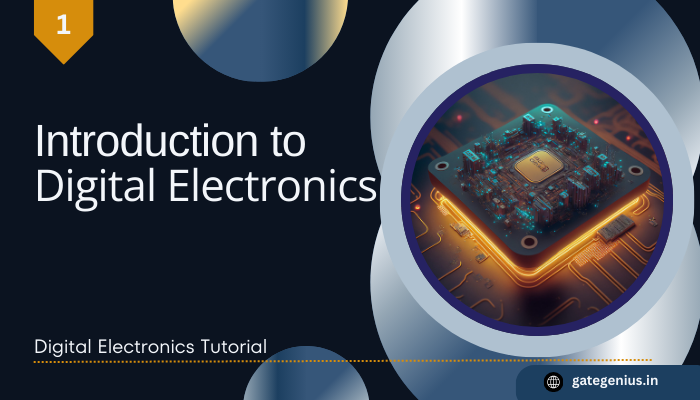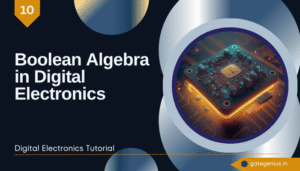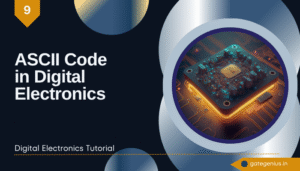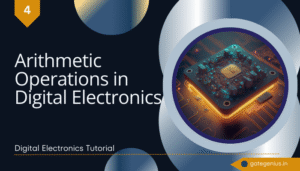Unlike analog electronics, which process continuous signals, digital electronics operate with discrete values, typically represented as binary digits (0 and 1). In this system, information is encoded using combinations of high (1) and low (0) voltage levels. This binary representation makes digital circuits highly reliable and less susceptible to noise, ensuring accurate data transmission and processing even in complex systems.
The Introduction to Digital Electronics is essential for understanding how modern electronic devices and systems work. This field powers everything from computers, smartphones, and digital cameras to embedded systems, communication networks, and industrial automation. Thanks to its high speed, efficiency, and ease of integration with software and microcontrollers, digital electronics forms the backbone of today’s digital age, shaping how we compute, communicate, and control machines.
What is Digital Electronics?
Digital electronics is the study of electronic circuits that manipulate and process digital signals. These signals are represented in binary form, meaning they exist only in two states:
0 (Low or OFF state)
1 (High or ON state)
This binary nature makes digital electronics more reliable, less susceptible to noise, and easier to design compared to analog systems.
Importance of Digital Electronics
Digital electronics is the backbone of today’s technological revolution, enabling everything from smartphones to space missions. Its principles power the devices we use daily and play a crucial role in computing, communication, and automation. The advantages of digital electronics make it indispensable in modern engineering and system design.
1. High Accuracy and Reliability
One of the most significant benefits of digital electronics is its accuracy and reliability. Unlike analog systems, digital signals are discrete and less susceptible to noise and distortion. This makes them ideal for applications that require precise data processing, such as medical equipment, scientific instruments, and financial systems.
2. Easy Data Storage and Processing
Digital systems excel in storing and processing vast amounts of information. Data can be saved on various digital storage devices without the risk of quality loss over time. Moreover, with the help of binary representation, operations like addition, subtraction, and logic comparisons become highly efficient and consistent.
3. High-Speed Operation
A key feature highlighted in the introduction of digital electronics is its ability to perform tasks at high speed. Digital circuits switch on and off rapidly, enabling billions of calculations per second. This speed is what powers everything from fast internet browsing to high-frequency stock trading and advanced AI applications.
4. Low Power Consumption
Energy efficiency is another critical advantage of digital electronics. Many digital devices, such as smartphones, smartwatches, and laptops, are designed to consume minimal power while delivering optimal performance. This efficiency extends battery life and reduces the environmental impact of electronic waste.
5. Easy Integration with Microprocessors and Microcontrollers
Digital electronics are easily integrated with microprocessors and microcontrollers, allowing seamless communication between hardware and software components. This integration forms the foundation of embedded systems used in robotics, home automation, automotive systems, and industrial controls.
Basic Components of Digital Electronics
Digital electronics is composed of essential building blocks that work together to process, store, and control data in various devices. Understanding these components helps in grasping the architecture of computers, embedded systems, and digital communication devices.
1. Logic Gates
Logic gates are the fundamental components used to implement digital circuits. They take one or more binary inputs and produce a single binary output based on logical operations.
- AND Gate – Outputs 1 only if both inputs are 1; otherwise, the output is 0. It mimics logical multiplication.
- OR Gate – Outputs 1 if at least one input is 1. It performs logical addition.
- NOT Gate – A single-input gate that inverts the input. If the input is 0, the output is 1, and vice versa.
- XOR Gate – Outputs 1 only when inputs are different. It is used in arithmetic and comparison circuits.
Logic gates form the basis of more complex circuits like adders, multiplexers, and memory units. They are used in processors, memory systems, and control units to make logical decisions.
2. Flip-Flops and Registers
Flip-flops are bistable devices, meaning they have two stable states (0 or 1), and are used to store one bit of data. They act as memory elements in sequential circuits.
- Flip-flops are triggered by clock signals and can store data as long as power is supplied.
- Types include SR, JK, D, and T flip-flops, each with different behavior and applications.
Registers are groups of flip-flops used to store multi-bit binary data. They temporarily hold data that the processor is currently working on and play a vital role in instruction execution, addressing, and data movement.
3. Multiplexers and Demultiplexers
These are combinational circuits used for routing signals.
- Multiplexers (MUX) select one input from multiple data sources and forward it to a single output line based on select inputs. This helps in optimizing wiring and improving circuit efficiency.
- Demultiplexers (DEMUX) perform the reverse operation by taking a single input and distributing it to one of many outputs based on control signals.
MUX and DEMUX are widely used in communication systems, data routing, and signal control in processors.
4. Counters and Timers
Counters are sequential logic circuits that count clock pulses. They are used to keep track of events, such as time intervals or the number of operations.
- Counters can be synchronous or asynchronous, depending on how the clock signal is distributed.
- They are commonly found in digital clocks, frequency counters, and timers.
Timers are specialized counters that generate delays or measure time intervals. Both are essential in controlling processes, managing schedules, and triggering actions at defined times.
5. Microprocessors and Microcontrollers
Microprocessors are integrated circuits that serve as the central processing unit (CPU) of computers and digital systems.
- They execute instructions, perform arithmetic and logic operations, and manage data flow between memory and peripherals.
- Used in personal computers, smartphones, and high-performance systems.
Microcontrollers, on the other hand, are compact systems with a CPU, memory, and input/output peripherals all on a single chip. They are designed for specific control tasks and are found in embedded systems like washing machines, microwaves, industrial robots, and IoT devices.
Applications of Digital Electronics
Digital electronics has transformed every aspect of our lives by enabling intelligent, fast, and reliable systems. Its applications span across industries, contributing to automation, efficiency, and enhanced performance in countless devices and services.
1. Computers and Smartphones
The core components of computers and smartphones—CPUs, GPUs, RAM, ROM, and storage devices—are built on digital circuits. Digital electronics enables the execution of complex instructions, fast data processing, and real-time multitasking. From browsing the internet to gaming and video conferencing, digital systems power it all with high efficiency and reliability.
2. Communication Systems
Modern communication relies entirely on digital signals. Mobile networks, WiFi, Bluetooth, and satellite communication use digital modulation techniques to transmit data clearly and quickly over long distances. Error correction, signal encryption, and high-speed data transmission are all possible due to digital electronics.
3. Consumer Electronics
Devices like digital TVs, digital cameras, music systems, smart watches, and home automation gadgets use digital technology for better performance and usability. These devices convert analog signals into digital form for clearer sound and images, improved storage, and smart features like voice control and AI integration.
4. Automobiles
Modern vehicles are equipped with digital control systems such as anti-lock braking systems (ABS), electronic fuel injection, navigation systems, and automated parking. These digital systems enhance safety, performance, fuel efficiency, and the overall driving experience. Advanced driver-assistance systems (ADAS) and self-driving technologies also heavily depend on digital electronics.
5. Medical Devices
In the healthcare sector, digital electronics plays a vital role in devices like MRI scanners, CT machines, pacemakers, and diagnostic monitors. These devices offer precise monitoring, accurate diagnosis, and automated control to assist healthcare professionals in delivering better patient care. Digital signal processing enhances image clarity and real-time feedback in surgeries and diagnostics.
Frequently
Q.1 What is Digital Electronics?
A 1 – Digital Electronics deals with electronic circuits that operate using binary numbers (0 and 1) to process, store, and transmit information.
Q.2 How is Digital Electronics different from Analog Electronics?
A 2 – Digital Electronics uses discrete values (0 and 1). Analog Electronics deals with continuous signals.
Q.3 What is a Combinational Circuit?
A 3 – A Combinational Circuit produces outputs based only on its current inputs (e.g., Adders, Multiplexers).
Q.4 What is a Sequential Circuit?
A 4 – A Sequential Circuit depends on both current inputs and past inputs (e.g., Flip-Flops, Counters).
Q.5 What is a Binary Number System?
A 5 – The Binary Number System uses only two digits, 0 and 1, to represent data in digital circuits.
Q.6 What are Logic Gates?
A 6 – Logic Gates are basic building blocks of digital circuits that perform logical operations like AND, OR, and NOT.
Q.7 What is a Flip-Flop?
A 7 – A Flip-Flop is a memory element used in digital circuits to store one bit of data.
Conclusion
Digital electronics has revolutionized technology by enabling fast, efficient, and reliable computing and communication systems. Understanding digital electronics is essential for engineers, programmers, and technology enthusiasts as it forms the backbone of modern innovation.
Would you like a more in-depth blog on specific topics like logic gates or microprocessors?
I hope you understand Introduction to Digital Electronics. So don’t forget to share this post with friends and anyone preparing for the GATE, UGC NET exams, or studying at the university



